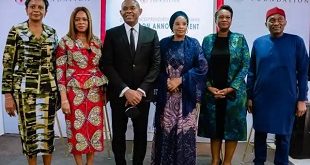
Six artists revolutionizing materiality and collaboration
Materiality in art is often evoked by artists as a response to how different objects in the community can be used to produce art. In the recent joint exhibition by Dr. Lilian Nabulime (Uganda) and Maria Brinch (Norway), the artists ventured into experimenting on how creative they can be working with different media and react to diverse themes of everyday life.
Nabulime did her signature sculptures constructed from hardwood, root stumps and copper/ aluminum plates collected from her immediate community and given a new life. She uses them to figuratively push messages on critical themes like HIV, womanhood, and contemporary human behaviours. Nabulime’s art is primarily a result of networking with her immediate community often the (young) women struggling with HIV prevention through behaviourism and cultural taboos like conversations around sex.
In certain instance, through such dialogue, the women, mostly her students, have helped produce the figurines. Brinch’s installations were fabricated from textiles bought from a bazaar market in Kampala. She used them to communicate the varied emotions layered within an individual. Brinch’s installations are inspired by working with communities in Myanmar; especially women. Through reaching out to such communities, she’s able to construct tapestries that are evocative of the varied emotions- although often muted- of the public. It was an amazing diversity in approach, with figurative messages layering each artwork. Visitors were wowed.
While Nabulime’s pieces were brisk and colossal, and filled with emotion, Brinch’s sculptures were subtler, very much muted, with messages is concealed within the fabric through the technique of folding the textile. These metaphorically convey the idea of concealment that we encounter in our everyday. And the material provides enormous possibilities.
Her technique involves painting, photography, and printing on the textile to breathe nuance into the work through distinct texture and multiplicity. This quality was most seen in her laminated prints of textiles hanging on a line. Lamination, in the literally context, is the process of manufacturing a material in multiple layers so that the composite material achieves improved strength or appearance. As the artist produces another layer for the artwork, another layer is inevitably concealed. That mirrors us human beings – we conceal a lot; emotions and more.
Nabulime and Brinch are bound by a common objective: championing visibility of women artists. Their exhibition is a product of an ongoing project-cum-revolution dubbed Tuwaye (Let’s Talk) that works towards creating safe spaces for female artists and artistic explorations aimed at neutralising tensions around female interaction, discussion, and creativity.
It comprises six art practitioners- including artists and curator- namely Sheila Nakitende, Stacey Gillian, Martha Kazungu, Maria Brinch, Hellen Nabukenya and Sandra Ssuubi. It is an ambitious move staged in a space oozing with patriarchal because it houses limousines of former heads of State like Kabaka Sir. Frederick Muteesa II, and former presidents Idi- Amin Dada and Milton Obote. There is also the stone figurine of the head of Milton Obote and the towering monument of King George. The exhibition curator said it is “a sign of emerging influence and presence of women in male dominated spaces.”The six artists combine to revolutionise the position of female artists in the region and globally.
The exhibition is curated by Martha Kazungu, Independent curator and co-founder of Tuwaye Revolution. The exhibit is showing in the basement of the Uganda Museum, located on Kira Road, Kampala.
****
 The Independent Uganda: You get the Truth we Pay the Price
The Independent Uganda: You get the Truth we Pay the Price


